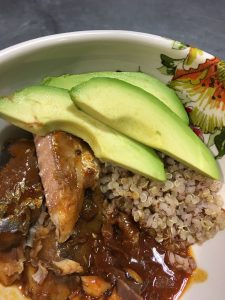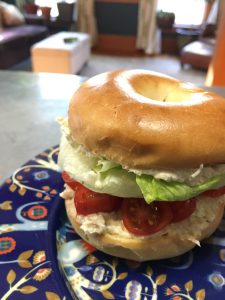Spicy Shrimp with Avocado and Mango
 Spicy Shrimp with Avocado and Mango
Spicy Shrimp with Avocado and Mango
(10 minutes, serves 1-2)
I had some frozen cooked shrimp that I’d bought by mistake (usually I prefer to buy raw and cook them, which lets you use them well in a greater variety of preparations), so I was a little stuck trying to decide what to do with them. I wanted spicy, fruity, rich and satisfying enough that I didn’t feel the need for additional bread or rice. This delivered nicely, and was particularly pleasant to eat on the back deck, enjoying a perfect early summer day.

2-3 T cilantro, chopped
2-3 T lime juice
1 T vegetable oil
1 t. salt
1 t. black pepper
3-5 chopped green chilies (optional)
1/2 lb. cooked shrimp, shelled
1 avocado, peeled and cubed
1 mango, peeled and cubed
1 t. raw red chili pepper (optional)
1. Combine cilantro, lime juice, oil, salt, black pepper, and green chilies in a bowl, beating quickly to emulsify dressing.

2. Stir in shrimp, avocado, and mango. Stir in red chili pepper if using. If you let it sit a little, maybe 15-20 minutes, it’ll blend better, but if you are impatient like me, you can just eat it straight up. Enjoy!


Quinoa & Red Rice Bowl with Mackerel Curry

I’ve been experimenting with alternatives to white rice, and alternatives to the traditional Sri Lankan way of eating rice, which is a big plate of rice with a little curry on top. That’s reasonably frugal, but also pretty high in starch and low in fiber (things I pay attention to as I get older and my metabolism slows down).

The problem is that it just doesn’t work to simply reduce the amount of rice and add in quinoa, because you can’t eat it the same way, rolling up the rice and curry into satisfying little balls with your hand and popping them in your mouth. The texture is wrong, the rice and curry won’t hold together in those proportions, etc.

So I figured maybe there was something to this quinoa bowl thing that’s so popular right now, and maybe if I tried to compose a Sri Lankan bowl, that might work better. The red rice + quinoa (cooked in a mix of chicken broth and water) on its own was a little dry, esp. after the first day, so I knew I wanted to add plenty of unctuous rich flavor. Fried egg was an obvious contender (egg hoppers are classic Sri Lankan food, and so delicious), and mackerel curry is nicely traditional (and deliciously spicy). Avocado lent another creamy element, and a cool balance to the heat, and a crisp kale-coconut-onion-tomato sambol was the perfect vegetal accompaniment.

I wasn’t even hungry, but dear reader, I DEVOURED this bowl, and was tempted to fry another egg and go back for seconds. Experiment: wildly successful. (Bonus, this would be easy to pack up and take to work to eat with a fork in the office.)

Tomorrow, maybe I’ll try it with beef curry, for poor Kevin, who doesn’t appreciate fish. Pretty sure that will also work great, keeping all the other elements the same. (A little seeni sambol added in wouldn’t hurt either…)

Sourdough Soup Bowl & Watermelon Salad
One consequence of writing a cookbook is that now when I eat out, I find myself taking mental notes and/or critiquing the food. These are two dishes from the Marriott I was staying at in Walnut Creek. The clam chowder was delicious, but the best part was how they served it in a little individual bread bowl, that they had buttered and crisped up before filling it with soup. Great contrasts of crispy bread exterior with soft, soup-soaked interior. Would make a fabulous autumn / winter appetizer or light meal.

I also liked this watermelon salad appetizer — so pretty! But the raspberry dressing was too sweet; it needed to be more citrus, to contrast with the candied nuts. And while the long cucumber slices are pretty, they required pulling out a knife, which none of the rest of the salad did, which was sort of annoying. I’d do it on a bed of round cucumber slices instead.

Red Curry Salmon with Rice, Carrot Salad, and Peanuts
 No real recipe — I just follow the instructions on the Maesri red curry paste can, combining the paste with coconut milk and a bit of brown sugar and fish sauce and simmering the salmon and bamboo shoots in that.
No real recipe — I just follow the instructions on the Maesri red curry paste can, combining the paste with coconut milk and a bit of brown sugar and fish sauce and simmering the salmon and bamboo shoots in that.
But I had fun building the tower for my dinner. ![]()
Thai Yellow Curry with Shirataki Noodles
 Experimenting with tofu shirataki noodles (shirataki is made of yam, and is extremely low-carb, low-calorie, and gluten-free); here I added them to a simple Thai yellow curry.
Experimenting with tofu shirataki noodles (shirataki is made of yam, and is extremely low-carb, low-calorie, and gluten-free); here I added them to a simple Thai yellow curry.
Tilapia with Quinoa & Rice
 Five minute dinner — well, mostly because of leftovers and accompaniments. I had some rice + quinoa leftover from yesterday, and a little kale salad, and of course, I try to keep myself stocked with coconut sambol and seeni sambol in jars in the fridge.
Five minute dinner — well, mostly because of leftovers and accompaniments. I had some rice + quinoa leftover from yesterday, and a little kale salad, and of course, I try to keep myself stocked with coconut sambol and seeni sambol in jars in the fridge.
So all I had to do was throw a tablespoon of butter in a hot pan, add a few tilapia filets, grind salt and pepper over them, flip them over a few minutes later, grind a little more salt and pepper on the other side, and when it was cooked through, serve with the rest of the food. Delish. The tilapia, seeni sambol, and rice/quinoa combo by itself would have been great — the other elements added pleasant fresher notes.
Shrimp and Potato Curry
 (30 minutes, serves 6)
(30 minutes, serves 6)
I had a busy work day yesterday, so it was six o’clock before I had a chance to look at the calendar and remind myself what the evening plans were — only to be reminded that I’d planned to go to a refugee-supporting potluck, which started at six o’clock!
We were supposed to bring something to share from countries that might be affected by a refugee ban, so I obviously wanted to bring Sri Lankan food. But I needed something I could make fast!
I also ideally wanted to bring a savory dish, and something with protein, because potlucks tend to lean heavy towards the sweets and the starches. I poked around in the freezer and pantry, confirmed I had frozen shrimp and russet potatoes; that meant I had a plan in place. By 6:30, I was transferring the curry into a disposable container and heading out the door; just a few minutes later, people were tucking into the food enthusiastically. Yum.
2 T vegetable oil
1 large onion, chopped fine
2 T ginger-garlic paste
1 t. mustard seed
1 t. cumin seed
1 stalk curry leaves
1 T chili powder
1 t. Sri Lankan curry powder
1/4 c. ketchup
1 t. salt
1 lb. frozen peeled raw shrimp
1 lb. russet potatoes, peeled and cubed small
1 T lime juice
1. Put potato cubes in a microwave-safe bowl with water to cover and microwave 5 minutes to par-boil. Let sit until needed.
2. While potatoes are microwaving, sauté onions in oil or ghee with ginger-garlic paste, mustard seed, cumin seed, and curry leaves, stirring on high, until onions are golden-translucent, about 5 minutes.

3. Stir in chili powder, curry powder, ketchup, and salt. Stir a minute or two to blend.

4. Add potatoes with their cooking water. Add shrimp (still frozen is fine). Continue cooking on high, stirring occasionally, until shrimp are cooked and pink, and potatoes are soft.


5. Add lime juice, give a final stir or two, and serve hot with rice or bread.
Curried Seafood Stew
 (30 minutes, serves 4)
(30 minutes, serves 4)
Creamy, tangy, richly-spiced, with just a little heat; I was aiming for something my daughter would love. Of course, feel free to amp up the chili powder or toss in some chopped Thai green chilies for a spicier version! Use whatever seafood you have on hand — I pulled some frozen tilapia and shrimp out to toss into this.
1 onion, chopped
1/4 c. oil or ghee
1 T ginger, grated
3 cloves garlic, chopped
1 t. mustard seed
1 t. cumin seed
1/2 t. fennel seed
1/2 t. methi seed
3 cloves
3 cardamom pods
1 stick cinnamon
1/2 t. chili powder
1/2 t. Sri Lankan curry powder
1 stalk curry leaves
2 pounds seafood, cleaned
1 can coconut milk
1 T lime juice
coriander for garnish
1. Saute onions in oil or ghee with ginger, garlic, spices, and curry leaves until onions are golden-translucent, about ten minutes.
2. Add seafood and coconut milk. Bring to a boil, stirring, then turn down heat to medium and cook another ten minutes or so, until seafood is cooked through.


3. Continue cooking until stew is desired thickness. Add lime juice and stir in, then cook a minute or two more. Serve hot with fresh rice and chopped coriander.
Whitefish Bagel
With the New Year, I’m trying to more consciously eat plenty of fish (and serve it to my kids). I’ve been eating lox and bagels for years, but only recently have I discovered whitefish salad. I think it was at my friends Ellen and Delia’s apartment in New York, where we had a weekend writing workshop and they laid out a beautiful bagel spread with lox and multiple fish spreads, along with everything else you might want. SO GOOD.
 Next up in the queue is figuring out how to make my own whitefish salad (please do feel free to point me to your favorite recipes!), but for right now, I’m very happy that my local Whole Foods carries ‘whitefish paté’ in their seafood case. Toast a bagel, layer it up with lettuce, tomato, capers, red onion (not pictured, because I was out, but trust me, that makes it even better), and you have yourself a delicious breakfast.
Next up in the queue is figuring out how to make my own whitefish salad (please do feel free to point me to your favorite recipes!), but for right now, I’m very happy that my local Whole Foods carries ‘whitefish paté’ in their seafood case. Toast a bagel, layer it up with lettuce, tomato, capers, red onion (not pictured, because I was out, but trust me, that makes it even better), and you have yourself a delicious breakfast.
(And for those counting calories, if you pile this all on a mini bagel, it’s still only about 200 calories, which is kind of amazing. Have two!)

